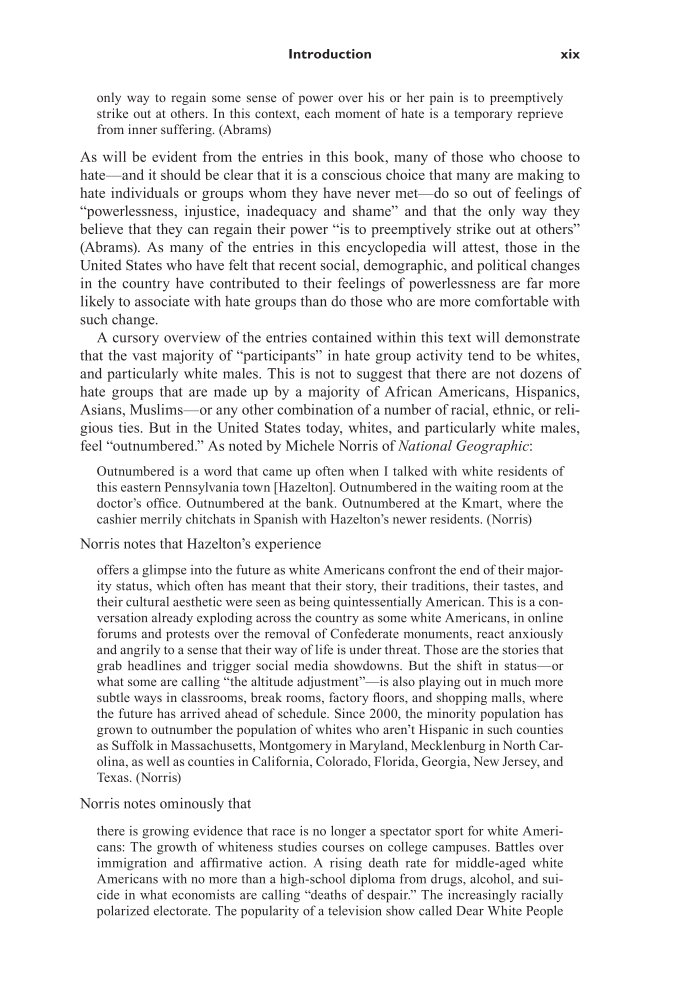Introduction xix only way to regain some sense of power over his or her pain is to preemptively strike out at others. In this context, each moment of hate is a temporary reprieve from inner suffering. (Abrams) As will be evident from the entries in this book, many of those who choose to hate—and it should be clear that it is a conscious choice that many are making to hate individuals or groups whom they have never met—do so out of feelings of “powerlessness, injustice, inadequacy and shame” and that the only way they believe that they can regain their power “is to preemptively strike out at others” (Abrams). As many of the entries in this encyclopedia will attest, those in the United States who have felt that recent social, demographic, and political changes in the country have contributed to their feelings of powerlessness are far more likely to associate with hate groups than do those who are more comfortable with such change. A cursory overview of the entries contained within this text will demonstrate that the vast majority of “participants” in hate group activity tend to be whites, and particularly white males. This is not to suggest that there are not dozens of hate groups that are made up by a majority of African Americans, Hispanics, Asians, Muslims—or any other combination of a number of racial, ethnic, or reli- gious ties. But in the United States today, whites, and particularly white males, feel “outnumbered.” As noted by Michele Norris of National Geographic: Outnumbered is a word that came up often when I talked with white residents of this eastern Pennsylvania town [Hazelton]. Outnumbered in the waiting room at the doctor’s office. Outnumbered at the bank. Outnumbered at the Kmart, where the cashier merrily chitchats in Spanish with Hazelton’s newer residents. (Norris) Norris notes that Hazelton’s experience offers a glimpse into the future as white Americans confront the end of their major- ity status, which often has meant that their story, their traditions, their tastes, and their cultural aesthetic were seen as being quintessentially American. This is a con- versation already exploding across the country as some white Americans, in online forums and protests over the removal of Confederate monuments, react anxiously and angrily to a sense that their way of life is under threat. Those are the stories that grab headlines and trigger social media showdowns. But the shift in status—or what some are calling “the altitude adjustment”—is also playing out in much more subtle ways in classrooms, break rooms, factory floors, and shopping malls, where the future has arrived ahead of schedule. Since 2000, the minority population has grown to outnumber the population of whites who aren’t Hispanic in such counties as Suffolk in Massachusetts, Montgomery in Maryland, Mecklenburg in North Car- olina, as well as counties in California, Colorado, Florida, Georgia, New Jersey, and Texas. (Norris) Norris notes ominously that there is growing evidence that race is no longer a spectator sport for white Ameri- cans: The growth of whiteness studies courses on college campuses. Battles over immigration and affirmative action. A rising death rate for middle-aged white Americans with no more than a high-school diploma from drugs, alcohol, and sui- cide in what economists are calling “deaths of despair.” The increasingly racially polarized electorate. The popularity of a television show called Dear White People
Document Details My Account Print multiple pages
Print
You have printed 0 times in the last 24 hours.
Your print count will reset on at .
You may print 0 more time(s) before then.
You may print a maximum of 0 pages at a time.






















































































































































































































































































































































































































































